Iran’s economy has gyrated, often coinciding with the success or failure of international diplomacy. The fluctuations have been reflected in all basic data points, including the value of its rial currency, oil exports, gross domestic product (GDP) and inflation. U.S. sanctions have added to the toll, especially by curtailing Iran’s ability to export oil and cutting Tehran’s connections to the international financial system. The gyration in Iran’s economy reflects gyrations in U.S. policy.
- The George W. Bush administration introduced sanctions on Iran’s nuclear program and for human rights abuses.
- During the Obama administration, Washington more aggressively designated Iran’s oil industry, the Central Bank, the rial, the automobile industry as well as human rights violators.
- In 2018, the Trump administration reimposed all the sanctions lifted by the Obama administration in 2016 to meet U.S. obligations under the nuclear deal brokered by the world’s six major powers in 2015. It also sanctioned top officials, including the supreme leader’s office, the Revolutionary Guards, the Central Bank, major foundations and businesses, including the metal industry.
The following graphs reflect Iran’s economy before, during and after sanctions. At the end is a full list of executive orders and legislation sanctioning Iran under the three administration.
Related Material:
- Sanctions 1: Impact of Iran's Oil Exports
- Sanctions 2: What Iran Wants Lifted
- Sanctions 3: Iran's Economy in 2020
- Sanctions 4: The "Chilling Effect" of U.S. Sanctions on Iran
- Sanctions 5: Trump's "Maximum Pressure" Targets
- Sanctions 6: U.S. Sanctions Many Iran Proxies
- Sanctions 8: Timeline of Sanctions
Economic Indicators: GDP, Unemployment and Inflation
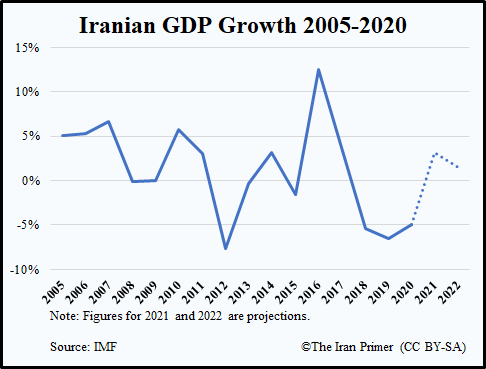
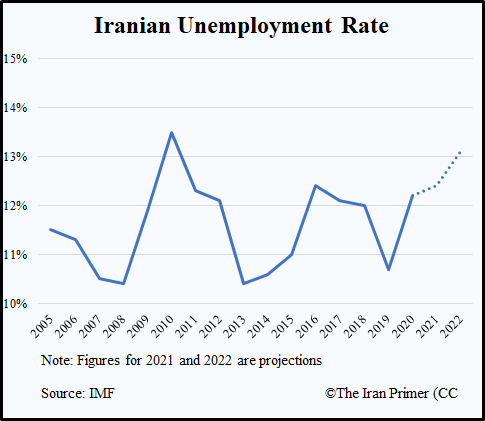
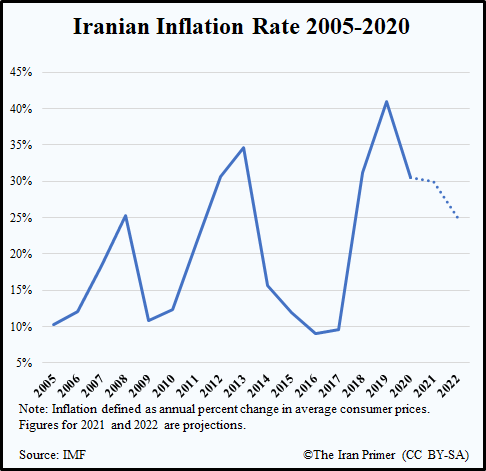
Currency Decline
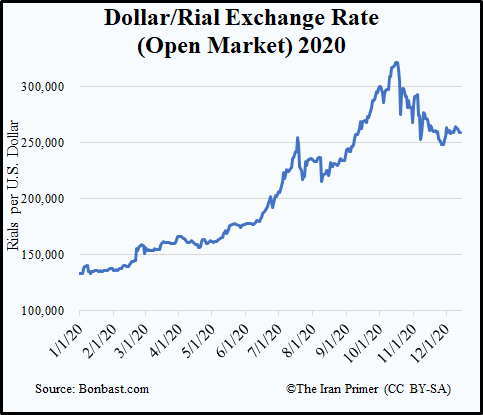
Oil Exports

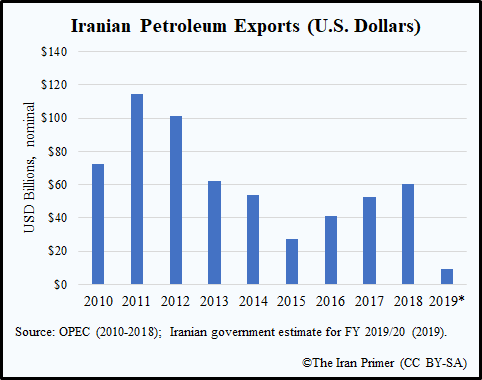
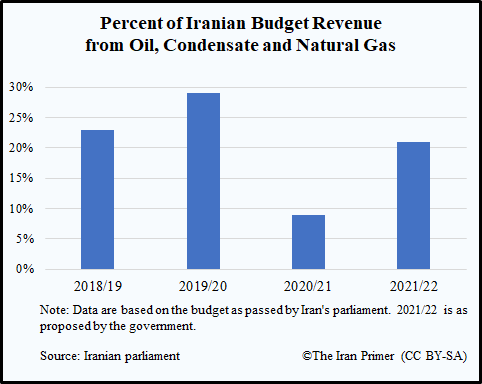
Non-oil Trade
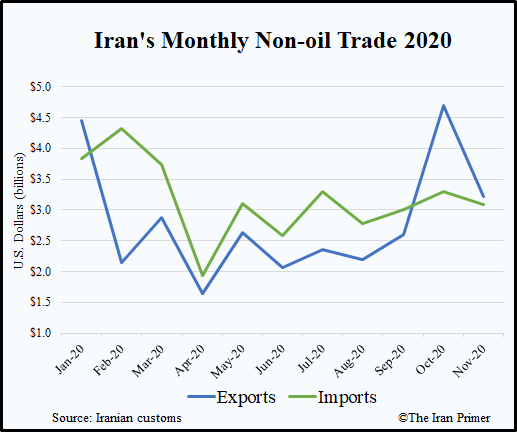
Sanctions
Since the 1979 revolution, Iran has faced layers of sanctions imposed by the United States for at least five different reasons organizations: nuclear proliferation, ballistic missile development, support for terrorist groups, human rights abuses and cyberattacks. Three presidents – George W. Bush, Barack Obama and Donald Trump—significantly increased sanctions in an attempt to get Tehran, most notably to limit its nuclear program and engage in diplomacy. The United States has sanctioned hundreds of Iranian top government and judicial officials, members of the military and proxy militias, scientists and manufacturers of military equipment, banks and businesses, foundations, and shipping and trading companies. The designations have been made under the following presidential executive orders and pieces of legislation:
George W. Bush administration:
- Executive Order 13224 (2001) imposed after the 9/11 attacks, froze the assets in the United States of people and entities accused of aiding or abetting terrorism or who posed a serious danger.
- Executive Order 13382 (2005) blocked assets of people and entities accused of supporting Iran’s nuclear proliferation and missile-related activities.
Barack Obama administration:
- The Comprehensive Iran Sanctions, Accountability, and Divestment Act (2010) amended the Iran Sanctions Act of 1996, which had required sanctions on companies involved in Iran’s energy sector. The new legislation further restricted investments in energy and cut off financing for the Revolutionary Guards.
- Executive Order 13553 (2010) designated Iranian officials responsible for serious human rights abuses after the 2009 Green Movement uprising.
- Executive Order 13574 (2011) blocked U.S. banks from investing in Iran’s petroleum sector, expanding sanctions first applied in the Iran Sanctions Act of 1996.
- Executive Order 13590 (2011) designated people involved in Iran’s energy and petrochemical sectors.
- Section 1245 of the National Defense Authorization Act for fiscal year 2012 (2011) froze the assets of Iranian financial institutions, including the Central Bank, and sanctioned any foreign financial institution that engage in or facilitated transactions with the Central Bank. The goal was to isolate Iran from the global economy.
- Executive Order 13599 (2012) froze the property of the Government of Iran and all Iranian financial institutions in the United States or held by Americans.
- Executive Order 13606 (2012) blocked the property and suspended the entry into the United States of people who helped the Iranian or Syrian governments engage in grave human rights abuses, notably for censorship, monitoring or tracking internet usage.
- Executive Order 13608 (2012) sanctioned people and institutions that facilitated the evasion of sanctions on Iran or Syria and suspended their entry into the United States.
- Executive Order 13622, or the Iran Threat Reduction and Syria Human Rights Act (2012), building on the 2012 National Defense Authorization Act, sanctioned private or public entities for knowingly involve in the trade of Iranian oil.
- The Iran Sanctions, Accountability, and Human Rights Act of 2012 (2012) targeted companies conducting business with National Iranian Oil Company and the National Iranian Tanker Company, including domestic and foreign insurers and shippers.
- Executive Order 13628 (2012) sanctioned individuals or entities that censored free expression and communications in Iran, which is considered a human rights abuse.
- Executive Order 13645 (2013) prohibited transactions in or involving Iranian rials. It also designated Iran’s automotive sector and anyone who materially assisted people on the list of Specially Designated Nationals and Blocked Persons.
Donald Trump administration:
- Executive Order 13846 (2018) reimposed sanctions lifted as part of the 2015 nuclear deal or Joint Comprehensive Plan of Action (JCPOA).
- Executive Order 13871 (2019) blocked all U.S. trade with Iran’s iron, steel, aluminum and copper sectors. It also threatened sanctions on any foreign bank that facilitated trade with these sectors.
- Executive Order 13876 (2019) sanctioned the assets of Supreme Leader Ayatollah Ali Khamenei, his office and anyone he appointed, or anyone who assists his office. It also barred any bank that conducted transactions related of the leader’s office or his appointees. Foreign Minister Mohammad Javad Zarif was sanctioned under this presidential order.
- Executive Order 13902 (2020) blocked transactions with and barred access to the U.S. financial system for any individual or entity operating in the construction, manufacturing, textiles or mining sectors of Iran.
- Executive Order 13949 (2020) authorized sanctions on foreign individuals or entities that supported Iran’s nuclear, missile and conventional arms-related activities. It followed the U.N. Security Council’s rejection of the Trump administration’s attempt to reimpose “snapback” sanctions that had been lifted by the United Nations as part of the 2015 nuclear deal.
